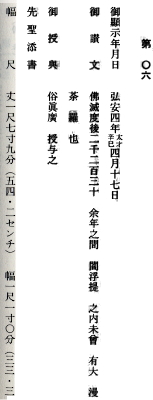
Nichiren Shonin
Gohonzon Shu

O'Mandalas by St. Nichiren
[1222-1282]

 |
Nichiren Shonin |  |
|
The explanation below refers to Mandala #50. |
 |  |
![]()
![]()
Gohonzonsh¯u (129 halographs)
|

|
|
Worldwide Directory | Site Map | Advertising | Buddhas | Discuss | Gohonzon | Gosho | Fuju_Fuse | Honmon_Butsuryu | Independents | Kishimojin | Lotus_Sutra | Mikkyo | Miraculous_Tales | Nichiren | Nipponzan | Nichiren_Shoshu | Nichiren_Shu | Pilgrimage | Prayer | Pure_Land | Queers | Reiyukai | Rissho_Koseikai | Soka_Gakkai | Stupas | Sutra_Library | Tendai | Theravada | WebRings | Women | Misc. | BuddhistInmates.net | Dharma-House.org | Ryuei.net | Sivartha's_Mind_Maps |
![]()
![]()
|
| ||||||
| ||||
| ||||